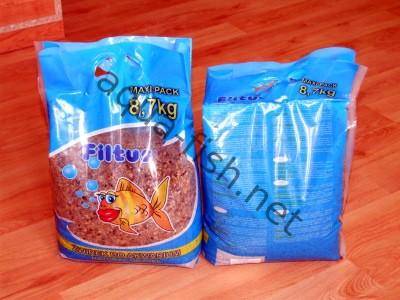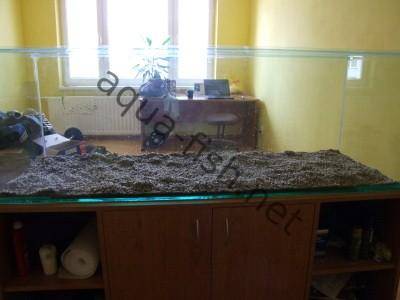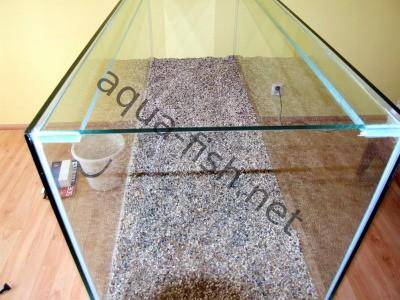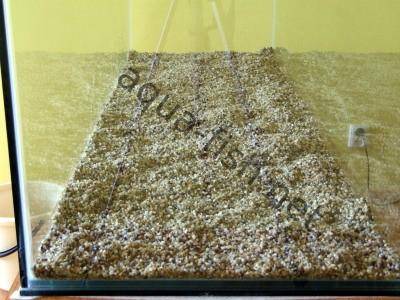Aquarium Substrate Guide - Calculator, Tips, FAQ, and Expert Advice
Quick links - Answers
Brief Description
This page provides details about different types of aquarium gravel, including a calculator to determine the amount of substrate you need, a FAQ section, and links to online suppliers. You're invited to share your experiences with us by using the form at the bottom of this page for sharing tips or asking questions! If you're looking to buy aquarium gravel, simply follow this link to find links to various merchants. Additionally, you may find the following pages helpful as they relate to fish tank substrates: Aquarium sand, Aquarium rocks, and Types of aquarium gravel!
Introduction
When you think of aquariums, the first things that likely come to mind are the colorful fish, lush green plants, and perhaps even that little plastic diver often found in fish tanks. And, of course, there are the gentle bubbles rising through the water, creating a peaceful atmosphere.
However, we often overlook the bottom substrate - whether it’s sand, gravel, soil, or clay. Despite being out of sight, it’s a crucial part of the underwater environment, especially in planted tanks. While most aquarium owners focus on heaters and filters, some also add a fertilizer-rich substrate for plant health. What many don’t realize is that the layer of gravel and other materials at the bottom of the aquarium plays an essential role in maintaining a healthy habitat for both fish and plants. The right depth of substrate is key to its effectiveness. But how do you know how much you need? Fortunately, there’s a simple calculator to help with that.
Substrate calculator
- Tank length X tank width X desired depth of substrate = substrate volume
- Substrate volumes are calculated as follows:
- Fine substrate (such as sand, soil, fertilizer, or clay): 600 cubic cm = 1 kg
- Medium substrate (like gravel): 1000 cubic cm = 1 kg
When setting up your tank, use this equation to ensure you buy the right amount of substrate.
Aquarium substrate serves multiple purposes. Most commonly, it adds a decorative touch, enhancing the aquarium’s appearance with colorful or natural tones. However, it also plays a crucial role in keeping fish healthy and supporting plant growth. Aquarium substrate helps fish orient themselves by distinguishing top from bottom, which prevents irritation caused by reflections and excessive light in clear-bottom tanks. While the choice of substrate - whether sand, soil, clay, or fertilizer-enriched - is often based on appearance, it’s essential for planted tanks where fertilizer supports plant growth.
This is the first layer of the substrate:
Aquarium substrate plays a key role by providing a home for beneficial bacteria that help create a healthy environment for your fish. The tank heater can speed up the growth of these bacterial colonies. The type of substrate you choose depends on your aquarium, as some substrates are not ideal for plants.
For fish-only tanks, the substrate should be no more than two inches (5.08 cm) deep. You can use any size substrate unless you have bottom-feeding fish, in which case finer gravel is recommended. The calculator above can help you achieve the correct depth.
Be cautious with substrate depth, especially with finer materials. Deeper substrate doesn’t get much oxygen, causing old food particles to rot and produce toxic hydrogen sulfide. If the substrate is too thick or compacted, it can harbor bacteria that generate this gas.
Typically, this gas is produced slowly and doesn’t affect the fish, so owners might not notice it. However, over time, hydrogen sulfide can build up. If the substrate is disturbed, such as when adding or moving objects, the gas can be released, posing a serious risk to fish.
To prevent this, regularly stir the aquarium substrate gently to release any gas before it becomes harmful. You can also add Trumpet Snails to the tank. These snails burrow through the substrate, helping to vent the gas and improving aeration.
If you’re planning a planted aquarium, the substrate is second only to light in importance. The right substrate is essential for plant growth and health. In a planted tank, the substrate must store and provide nutrients to the plant roots.
For a planted aquarium, consider creating a two-layer substrate. The bottom layer should be nutrient-rich to support healthy plants. Vermiculite is a good option because it slowly releases nutrients over time. This layer should be deep enough to cover the plant roots, about two inches (5.08 cm).
The top layer can be regular gravel or sand, about one and a half to two inches (5.08 cm) deep.
Some materials aren’t recommended as aquarium substrate. For example, avoid using highly colorful painted gravel, as the paint may flake off and irritate your fish.
Glass pebbles, while pretty, can also be problematic. Light reflecting through the glass can disorient and irritate your fish, so they shouldn’t be a top choice.
What's the Best Aquarium Substrate for You?
If you're setting up a fish-only aquarium, common aquarium gravel is a solid choice. It’s safe for both the water and the fish. You can also use it as the top layer in a planted aquarium.
Sand is another excellent option for aquarium substrate. You can choose play sand, like the kind used in children’s sandboxes, or sandblasting sand. Since sand is a natural substrate, your tank’s inhabitants will feel right at home along the tank bottom.
Explore More Aquarium Substrate Resources and Shops
If you're looking to buy substrate for your fish tank, check out Gravel & Substrates at AquariumSupplies.CA. You can also explore theis page for tips on using gravel in home fish tanks: Aquarium Plant Substrates at Animal-World.Com. If any link doesn’t work, let us know! Plus, feel free to share your thoughts and experiences with gravel, sand, or any type of substrate here; just fill out the form at the bottom of this page.
Additional Answers
This page was updated on March 18th 2011 to include questions and answers that were previously published on aqua-fish.net/answers. If you have your own questions, feel free to use the form at the bottom of this page to ask them. Just make sure your question isn’t already covered here.
-
Why do fish tanks need gravel?
Answer: If your tank doesn’t have plants, then gravel isn’t necessary. Plants need gravel to anchor their roots, but fish can thrive with no substrate or just sand.
-
How do I replace the gravel when cleaning the aquarium?
Answer: It’s not recommended to replace the gravel when cleaning the aquarium, as it contains beneficial bacteria that help maintain a healthy environment. Instead, clean the existing gravel with a gravel cleaner. If you must replace the gravel for other reasons, temporarily move your fish to a separate tank, such as a quarantine tank. Be sure to use a product that helps reduce stress in your fish during the transition.
-
What does an under-gravel filter do?
Answer: An under-gravel filter performs the same function as a traditional filter but occupies less space outside the tank. For more information on aquarium filter systems, you can read this article: link.
-
What type of gravel should I use in my aquarium?
Answer: The choice of gravel type and size for your aquarium depends on the fish and other inhabitants in your tank. Some fish need specific substrates for breeding, while others may consume small gravel, which can lead to health and swimming problems.
-
What type of gravel is suitable for aquariums?
Answer: Use inert gravel that won’t change the water parameters in your tank. Avoid sharp-edged gravel as it can injure your fish. Dark-colored gravels are better for timid fish, as they provide a more calming environment.
-
Which substrate is best for my aquarium?
Answer: Most aquarium enthusiasts use either sand or gravel, while some tanks are left bare without substrate. For species like Corydoras or sensitive catfish, sand is preferable because gravel can harm their barbels.
Suppliers
If any of the links below are not working, please let us know using the form at the bottom of this page. All links will open in a new window or tab.







